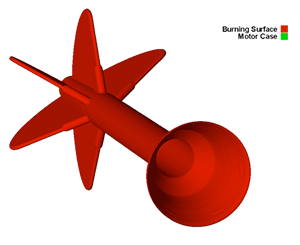SPP’12™ Code
The Solid Performance Program, SPP’12™ is the latest version of the JANNAF standard for performance predictions of Solid Propellant Rocket Motors (SRMs). The analysis consists of two parts: nozzle performance and motor performance.
The SPP’12™ nozzle module analyzes and summarizes the performance loss mechanisms into four categories:
- Two Phase Flow losses
- Divergence losses
- Boundary Layer losses
- Chemical Kinetics losses
The motor performance analysis consists of a 3D/axisymmetric grain design module and two internal ballistics modules. The grain design module is internally linked with both one-dimensional motor ballistics modules. The motor stability can be analyzed with the axial-mode Standard Stability Prediction (SSP) code which is internally linked with the grain design and ballistic modules to define burn rates, motor surface, and port areas required by the SSP.
New in SPP’12.8™
STS - Subsonic/Transonic Navier-Stokes Solver
Option to use the JANNAF Thermodynamic file (5-Coefficient fit for the specific heat) and CEA Thermodynamic file (7-Coefficeint fit for the specific heat)
PNS - Parabolized Navier-Stokes solver
TAB - Blowout port thrust termination capability in the Time Accurate Ballistics module
TAB - Pintle option
Option to combine STS and PNS solutions in a single Tecplot file
GD Viewer - Solid viewer for validating and animating grain design input geometries
Graphics - Graphical support for both TecPlot™ and ParaView 3-D graphics packages
The SPP’12™ is sufficiently fast and robust providing performance predictions for extensive parametric studies, and sufficiently accurate to provide flowfield and performance solutions for detailed studies. The 3-D graphic viewers have been improved, and include the 3-D surface plots. The following table is a list of features and capabilities of the SPP’12™.
Features of SPP’12™
Two supersonic flow solvers and an optional subsonic/transonic solver:
- MOC - Two-Dimensional Method of Characteristics solution with fully coupled two phase flow.
- PNS - Parabolized Navier-Stokes solver for solid propellant rocket nozzle performance calculations with fully coupled finite rate kinetics, several turbulence models, and coupled two phase flow.
- STS - An optional Navier-Stokes chamber and transonic flow field solver with fully coupled finite rate kinetics and two phase flow models. The STS is fully compatible with inflow and wall boundary condition options and is available to the PNS/chamber flow field option.
ODE/CET module calculates the ideal nozzle performance.
ODK, STS, or PNS modules calculate the finite rate gas phase chemistry losses.
SPP’12™ models chemical reactions with a generalized reaction package that includes 3rd body efficiencies and four different reaction rate forms. Chemical reactants can be selected from a library supplied with the program. A library of finite rate chemical reaction sets is included. There are presently 12 sets available, and these have been screened to include only the most important reactions for rocket engine performance prediction.
TD2P or PNS modules calculate the divergence and particle losses. Kinetics losses are modeled in a coupled fashion in the PNS module.
The Grain Design and Ballistics Module (GDBM) now supports dual propellant grains.
ODE/ODK modules include the calculation of ionic species.
IGT - 1-D time dependent true ignition transient module (IGT)
TAB – Full time accurate ballistics (TAB) module in the GDBM.
Includes the option to simulate thrust termination with a blowout port.
3-D graphic support for the 3-D grain design module. A new grain volume 3-D viewing package is now available along with the original 3-D surface viewing module. Both viewers are capable of producing burnback animations.
The graphic outputs include:
- Tecplot™ - commercial plotting package – Figure 1
- ParaView - freeware plotting software – Figure 2
SSP linkage – The axial mode SSP is linked to the 3-D Grain Design and Ballistics module.
Improved file handling and error routines; reducing disk space and improves tracking of result files.
Includes improved output files; auxiliary ASCII files with tabulated and summary data
Available on Windows and Linux platforms.

